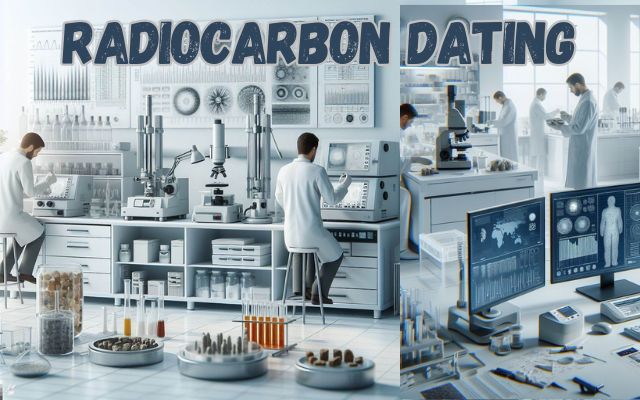
Radiocarbon dating, a term that may seem complex, but holds the key to unlocking the past. It’s a scientific method that has revolutionized our understanding of history, archaeology, and the very age of our planet. But what exactly is radiocarbon dating? How does it work, and why is it so important?
In simple terms, radiocarbon dating is a technique used by scientists to determine the age of objects, namely organic materials, by measuring the amount of carbon-14 they contain. Carbon-14, or radiocarbon, is a naturally occurring radioactive isotope of carbon that is formed in the atmosphere and absorbed by living organisms. When an organism dies, it stops absorbing carbon-14, which then begins to decay at a known rate. By measuring the amount of carbon-14 left in a sample, scientists can estimate when the organism died, or in other words, the age of the sample.
This method has been instrumental in dating ancient artifacts, studying climate change, and even determining the age of the Earth itself. However, like any scientific method, radiocarbon dating has its limitations and challenges.
In this guide, we will delve deeper into the fascinating world of radiocarbon dating. We will explore its history, understand its process, discuss its applications, and address its limitations. So, let’s embark on this journey to unravel the mysteries of radiocarbon dating together.
History of Radiocarbon Dating
The concept of radiocarbon dating originated with American physicist Willard F. Libby in 1946, revolutionizing the study of prehistory and becoming the gold standard for establishing chronologies in archaeology.
Radiocarbon dating relies on the principle that living organisms absorb carbon-14, a radioactive isotope, from the atmosphere. When an organism dies, carbon-14 absorption ceases, and the isotope begins to decay at a known rate. Analyzing the residual carbon-14 in a sample allows scientists to estimate the age of the organism or the sample.
However, scientists soon recognized fluctuations in atmospheric carbon-14 levels due to solar activity, atomic bombs, and fossil-fuel burning. To address this, radiocarbon dates require calibration against independent measurements, often derived from ancient wood with annual growth rings directly tied to calendar years.
In the 1980s, internationally accepted calibration curves were developed, primarily based on tree-ring measurements spanning the past few thousand years. These curves have undergone periodic updates with new global data.
The most recent update, IntCal20 in 2020, incorporates nearly twice the data of its 2013 predecessor. This enhanced calibration curve holds the potential to prompt a reevaluation of the ages of various sites, artifacts, and events globally.
The history of radiocarbon dating underscores the persistent pursuit of knowledge by scientists, marked by continuous learning, improvement, and refinement to enhance our understanding of the past.
Understanding Radiocarbon Dating
Radiocarbon dating, or carbon-14 dating, relies on the decay of radiocarbon (carbon-14) for age determination. Carbon-14 is formed in nature through the interaction of neutrons with nitrogen-14 in the Earth’s atmosphere. These neutrons result from cosmic rays interacting with the atmosphere.
Radiocarbon from atmospheric carbon dioxide enters the biological carbon cycle, absorbed by green plants and passed on to animals through the food chain. In a living organism, carbon-14 decays slowly, with the loss being replenished as long as the organism takes in air or food. Upon death, the organism stops absorbing carbon-14, leading to a steady decrease in its tissues’ radiocarbon content. The half-life of carbon-14 is 5,730 years, allowing the estimation of an organism’s death date by measuring its residual radiocarbon.
A recent advancement in radiocarbon dating involves a high precision record of atmospheric radiocarbon shifts beyond 14,000 calendar years BP (Before Present). This enhancement enables more accurate dating of sub-fossil samples, contributing to establishing the chronology of past environmental and climate changes during glacial times. The development of this record is crucial for constructing future radiocarbon dating calibration curves.
The recent upgrade, published in Communications Earth & Environment, captures significant variations in atmospheric radiocarbon levels based on a 1000-year tree-ring chronology. This research detected greater variations between 18,475 and 17,350 calendar years BP compared to the previous calibration curve, IntCal202.
A new tree-ring chronology was established using 33 larch subfossil trees from the Revine site in the Venetian Prealps (Northeastern Italy), which grew during key deglaciation intervals. Comparisons with 10 Be in ice cores, another cosmogenic radionuclide produced by cosmic rays in the atmosphere, allowed the research group to link reconstructed changes in atmospheric radiocarbon to periodic changes in solar activity during the Last Glacial period.
Applications of Radiocarbon Dating
Radiocarbon dating, a versatile technique spanning Earth and social sciences, holds paramount significance in various fields.
Foremost among its applications is in archaeology, where it serves as a cornerstone for dating ancient artifacts and establishing the ages of historical sites. A notable example is its pivotal role in determining the age of the ancient Minoan settlement on Santorini, a Greek island frozen in time by volcanic debris from the Thera eruption over 3,500 years ago. Radiocarbon dating unveils the mysteries concealed within multistory houses adorned with vibrant wall frescoes.
Beyond archaeology, radiocarbon dating finds utility in geology and climatology. Scientists employ this method to explore climate change dynamics by dating ancient ice cores and sediments. For instance, the age determination of ancient wood samples using radiocarbon dating contributes valuable insights into past climatic conditions.
The technique also plays a pivotal role in unraveling the complexities of human origin and migration. By dating human remains and artifacts, scientists can trace the intricate patterns of ancient human populations, shedding light on the historical tapestry of our species.
Furthermore, radiocarbon dating extends its reach into forensics, where its capabilities are showcased in the emerging field of accelerator mass spectrometry (AMS) dating. A recent e-learning course underscores the power of radiocarbon dating in forensic AMS applications, emphasizing its contribution to unraveling mysteries in forensic investigations.
Radiocarbon dating stands as a linchpin in various scientific endeavors, offering a powerful tool for dating, tracing historical narratives, and contributing to our understanding of the Earth’s past and the intricate stories woven by humanity.
Limitations and Challenges of Radiocarbon Dating
Radiocarbon dating serves as a crucial tool in archaeology and related fields, yet it grapples with inherent limitations and challenges. One primary constraint lies in its exclusive applicability to organic materials, such as bone, wood, or shell, rendering it ineffective for dating inorganic substances like rocks or metal. This intrinsic limitation restricts its utility in certain archaeological contexts.
Additionally, radiocarbon dating confronts the challenge of assuming a constant concentration of carbon-14 in the atmosphere over time. This assumption falters in the face of fluctuations induced by solar activity, atomic bomb detonations, and fossil-fuel burning. Consequently, variations in atmospheric carbon-14 levels necessitate the calibration of radiocarbon dates against independent measurements, primarily derived from ancient wood samples.
The method’s precision further hinges on the quality of the sample, introducing another obstacle. Contamination from more recent materials can significantly distort results, emphasizing the critical need for meticulous sample preparation and handling to ensure the accuracy of the dating process.
Despite these inherent challenges, scientists persist in refining radiocarbon dating to enhance its accuracy and reliability. The latest advancement, represented by IntCal20, signifies a substantial improvement, drawing from nearly double the data of its 2013 predecessor. This updated calibration curve holds the potential to prompt a reevaluation of the ages attributed to various sites, artifacts, and events globally. In the pursuit of overcoming these challenges, ongoing efforts in research and methodology aim to fortify radiocarbon dating as a robust and dependable tool for unraveling the mysteries of the past.
Case Studies
Radiocarbon dating has been instrumental in numerous groundbreaking discoveries. Here are a few notable case studies:
Ancient Thera: More than 3,500 years ago, a catastrophic volcanic eruption struck ancient Thera, known today as the Greek island of Santorini. In the 1960s, archaeologists uncovered a Minoan settlement frozen in time, with vibrant wall frescoes decorating multistory houses, all buried by volcanic debris. Radiocarbon dating was crucial in determining the date of this cataclysm.
Siberia’s Oldest Modern Human Fossils: The recalibration of radiocarbon dating had implications for the estimated ages of many finds. For instance, Siberia’s oldest modern human fossils, according to the latest calibrations, are 1,000 years younger than previously thought.
Capitoline Wolf: A new e-learning course on accelerator mass spectrometry (AMS) dating reveals the power of radiocarbon dating in forensic AMS applications. One of the case studies discussed in the course is the Capitoline Wolf.
Bacho Kiro, Bulgaria: Using the new radiocarbon 3.0 method, researchers were able to reconstruct more accurately the movements of ancient hominids, which occurred at major European archaeological sites, during different climatic phases.
These case studies highlight the power and versatility of radiocarbon dating in uncovering the secrets of the past.
Future of Radiocarbon Dating
The future of radiocarbon dating looks promising with continuous advancements in technology and methodology. The most recent update, known as IntCal20, draws from nearly twice the data of the previous curve from 2013.
This new calibration curve may prompt scientists to reevaluate the age of sites, artifacts, and events around the world. Moreover, the advent of the new radiocarbon 3.0 method promises to reveal valuable new insights about key events in the earliest human history. As we move forward, we can expect even more accurate and reliable results from radiocarbon dating.
FAQ
What is Radiocarbon Dating in Simple Terms?
Radiocarbon dating is a method used by scientists to determine the age of an object containing organic material. It works by comparing the three different isotopes of carbon. The heaviest isotope, Carbon-14 (C-14), is radioactive and decays over time.
What is Carbon Dating?
Carbon dating, also known as radiocarbon dating, is a method that uses the radioactive isotope Carbon-14 to determine the age of organic materials up to about 50,000 years old.
What is Radiocarbon Dating for Kids?
Radiocarbon dating is a way of telling how old an object is. It’s used to date things like bone, cloth, wood, and plant fibers that were once part of living things. When a plant or animal dies, it stops taking in carbon, and the Carbon-14 it contains begins to decrease. By measuring the remaining Carbon-14, scientists can estimate when the organism died.
Why is Radiocarbon Dating Used?
Radiocarbon dating is used to determine the age of organic materials that originated from living organisms. It’s based on the decay of the Carbon-14 isotope, which is constantly being created in the Earth’s atmosphere by the interaction of cosmic rays with atmospheric nitrogen.
Why is it Called Carbon Dating?
It’s called carbon dating because it’s based on the decay of the Carbon-14 isotope. This isotope is absorbed by living organisms from the atmosphere. Once the organism dies, it stops absorbing Carbon-14, and the isotope begins to decay. By measuring the remaining Carbon-14, scientists can estimate the age of the organism.
What is Radiocarbon Dating Class 11?
Radiocarbon dating is a method for determining the age of an object containing organic material. It’s based on the decay of the Carbon-14 isotope, which is absorbed by living organisms from the atmosphere. Once the organism dies, the Carbon-14 begins to decay, and by measuring the remaining Carbon-14, scientists can estimate when the organism died.
How is Radiocarbon Dating Done?
Radiocarbon dating is done by measuring the amount of Carbon-14 remaining in a sample and comparing it against its known half-life. When organisms are alive, they constantly replenish their Carbon-14 supply, providing them with a constant amount of the isotope. Once the organism dies, the Carbon-14 begins to decay.
Is Carbon Dating a Theory?
Carbon dating is not a theory but a well-established scientific method used to determine the age of organic materials. It’s based on the decay of the Carbon-14 isotope, which is absorbed by living organisms from the atmosphere.
- Ethical Considerations in CRISPR Technology: Balancing Promise and Responsibility
- How Morse Code is Still Used in Modern Technology
- How Smart Wearables Continue To Steer Technology Towards The Future
- The Intersection of Technology and Education: How Technology is Changing the Way We Learn.
- The Future of Electric Cars: How Technology is Revolutionizing the Automotive Industry
Conclusion
Radiocarbon dating has significantly contributed to our understanding of human history and the natural world. Despite its limitations, it remains a powerful tool in scientific research. The continuous advancements in technology and methodology, such as the latest calibration curve IntCal20 and the new radiocarbon 3.0 method, promise more accurate and reliable results in the future.
However, the ongoing decline in atmospheric 14C/C due to increased fossil-fuel emissions has consequences for radiocarbon dating. Therefore, the future of radiocarbon dating is intertwined with our actions towards limiting global warming.






